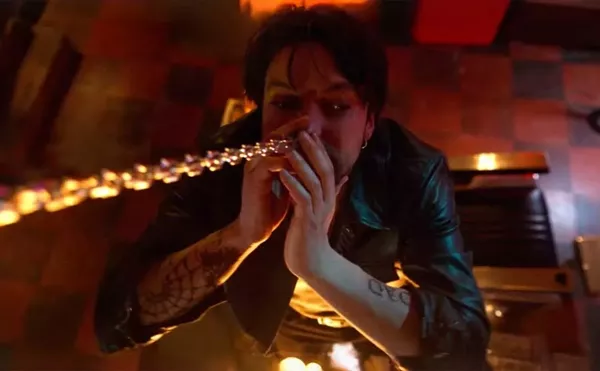
Audio By Carbonatix
[
{
"name": "GPT - Leaderboard - Inline - Content",
"component": "35519556",
"insertPoint": "5th",
"startingPoint": "3",
"requiredCountToDisplay": "3",
"maxInsertions": 100,
"adList": [
{
"adPreset": "LeaderboardInline"
}
]
}
]
In Fabric of Fear: Art after 9/11, hosted by Detroit’s Gallery 555, New York artist Chrissy Conant presents an installation featuring a plush wool blanket covering a bed. This blanket has been adorned with the terror alert spectrum in soothing pastels. Above the bed, five Plexiglas panels echo that spectrum. The nightstand is complete with duct tape, flashlight, bottled water and a terror-alert choker necklace. Conant’s installation is disarming. It creates a safe, intimate and comfortable bedroom setting, while questioning the illusory nature of security. The presentation is charming and inviting, yet insidious.
Before September 11, 2001, for those of us living in the United States, terrorism was seen as something that happened “over there.” How then do we make sense of this post-9/11 landscape? What’s needed is assistance in navigating this uncertain terrain and new ways of looking at the world — two fundamental strengths of art.
Curated by Ann Arbor artist Brenda Oelbaum, Fabric of Fear features more than a dozen local and international artists. It is an aesthetically and conceptually powerful exhibition dealing head-on with the climate of fear.
In addition to its alliterative allure, the show’s title metaphorically speaks to commonalities across cultures — the threads now binding us together. The meaning is also literal, as much of the work on display is of fabric.
Margaret Parker offers up a tremendous amount of work, including an entire series in which she transforms ordinary T-shirts into distinctive sculptural objects through imaginative cutting and hanging. The works reference such things as the “Paradise of the 47 Virgins” (the supposed reward for martyrs) and U.S. prison camp abuses. The former is made of a splayed-out, tie-dye shirt, and the latter out of a Darth Maul tee. Parker’s other work consists of paintings of falling bodies, airplanes and the negative space of the twin towers.
The towers appear again, along with depictions of the U. S. “war on terror,” in more representational fashion, as Afghan rug tapestries. These are perhaps the most disturbing works in the show, because they were not intended as political art, but as craft. Made by Afghan women, they’re meant as souvenirs for U.S. soldiers. Of particular beauty is a runner that, at first glance, seems decorated with star patterns and a rectangular border. On closer inspection, the stars are actually B-52 bombers and the borders are cluster bombs and food ration kits.
For her “Axis of Evil” series, curator Oelbaum created rugs from latch-hook kits. She also made painterly portraits of Osama bin Laden, Kim Jong Il, Saddam Hussein, President Bush and Vice President Cheney. Also included is a tape of a performance piece in which she invites people on the street to enter her flag-covered tent and wipe their feet on the Osama rug. The enthusiasm, confusion and apprehension this generated is captured well by filmmaker David Holtek, whose works on paper also appear in the show.
In another video presentation, highly prolific and acclaimed New York artist Rainer Ganahl stands in front of an Afghan tapestry made to resemble TV news logos. In an age when everyone’s a suspect and not knowing the right thing to say can land you in prison, he tersely recites five phrases in 11 different languages, including, “I am not a terrorist.”
Canadian painter Mendelson Joe turns up the intensity with overtly political paintings such as “Death Mask,” an incredibly expressive, horribly contorted, Dr. Strangelove-version of Dick Cheney. Bright red irises encircling skulls in the pupils burn through the otherwise deathly gray portrait.
Much more deserves mention: Christy Kelly-Bentgen’s “1000 Nails”; Lynda Cole’s hauntingly beautiful photographs of the towers, Jeremy Barbour’s portrait of a terrorist on a stretched towel, a play on the derogatory term “towel head”; Amy Feigley’s woven political statements; and gallery director Monte’s altar to our addiction to violence.
Art can offer a fresh perspective in this time when the “global war against terror” has been declared indefinitely. Fabric of Fear is necessary and essential viewing.
Through Sept. 30 at Gallery 555, 4884 Grand River Ave., Detroit; 313-894-4202.
An interview with Monte, director of Gallery 555, will be appearing on the thedetroiter.com this week.
Nick Sousanis is the arts editor of thedetroiter.com, a Detroit arts and cultural Web magazine. Send comments to letters@metrotimes.com




